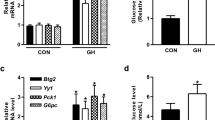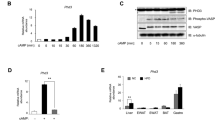Abstract
The main purposes of this study were to investigate the effects of α-linolenic acid (ALA) on the insulin-like growth factor (IGF) system of porcine primary hepatocytes with or without growth hormone (GH) or insulin and the potential role of peroxisome proliferator-activated receptor α and -γ (PPARα/γ) pathway. We found that 1 μM ALA increased IGF-I secretion from hepatocytes at 48 and 72 h. Expression of hepatocytes IGF-I, IGF-II, GH receptor (GHR), insulin receptor (IR), IGF-binding protein 3 (IGFBP3), and IGFBP4 mRNAs was up-regulated by ALA treatment. GH (15 nM) alone or co-treated with ALA increased hepatocytes IGF-I secretion and the expression of GHR and IGFBP1 mRNAs, but down-regulated IGFBP5 mRNA compared with appropriate control across ALA. GH also enhanced the ALA-induced increase in the transcript levels of IGF-II and GHR, but tended to attenuate that of IGFBP4. Insulin (1 μM) alone or co-treated with ALA improved IGF-I secretion and the expression of IGFBP3 mRNA, but decreased IGFBP1 mRNA versus appropriate control across ALA. Insulin also up-regulated the expression of GHR, IR, IGFBP3, and IGFBP4 mRNAs, and tended to prevent the transcript levels of IGF-I and IGFBP4 improved by ALA. Both PPARγ agonist rosiglitazone and its antagonist GW9662 could elevated the IGF-I secretion in dose-dependent manner but they had no interaction with ALA. However, GW7647, a PPARα agonist, increased IGF-I secretion dose-dependently, but the antagonist GW6471 was without effect. Moreover, GW6471 prevented the IGF-I promoting effect of ALA. This suggests that the IGF-I promoting effect of ALA may be mediated by the PPARα pathway.





Similar content being viewed by others
References
Gabillard JC, Kamangar BB, Montserrat N (2006) Coordinated regulation of the GH/IGF system genes during refeeding in rainbow trout (Oncorhynchus mykiss). J Endocrinol 191(1):15–24. doi:10.1677/joe.1.06869
Lee PD, Conover CA, Powell DR (1993) Regulation and function of insulin-like growth factor-binding protein-1. Proc Soc Exp Biol Med 204(1):4–29. doi:10.3181/00379727-204-4363
Govoni KE (2011) Insulin-like growth factor-I molecular pathways in osteoblasts: potential targets for pharmacological manipulation. Curr Mol Pharmacol 30(3):275–284
Thissen JP, Ketelslegers JM, Underwood LE (1994) Nutritional regulation of the insulin-like growth factors. Endocr Rev 15(1):80–101. doi:10.1210/edrv-15-1-80
Gannon MC, Nuttall FQ (2011) Effect of a high-protein diet on ghrelin, growth hormone, and insulin-like growth factor-I and binding proteins 1 and 3 in subjects with type 2 diabetes mellitus. Metabolism. doi:10.1016/j.metabol.2011.01.016
Veldhuis JD, Iranmanesh A (1996) Physiological regulation of the human growth hormone (GH)-insulin-like growth factor type 1 (IGF-I) axis: predominant impact of age, obesity, gonadal function, and sleep. Sleep 19(10):S221–S224
Chia DJ, Young JJ, Mertens AR, Rotwein P (2010) Distinct alterations in chromatin organization of the two IGF-I promoters precede growth hormone-induced activation of IGF-I gene transcription. Mol Endocrinol 24(4):779–789. doi:10.1210/me.2009-0430
Wu M, Hall JB, Akers RM, Jiang H (2010) Effect of feeding level on serum IGF1 response to GH injection. J Endocrinol 206(1):37–45. doi:10.1677/joe-10-0015
Goya L, de la Puente A, Ramos S, Martin MA, Escriva F, Alvarez C, Pascual-Leone AM (2001) Regulation of IGF-I and -II by insulin in primary cultures of fetal rat hepatocytes. Endocrinology 142(12):5089–5096. doi:10.1210/en.142.12.5089
Chase CC Jr, Elsasser TH, Spicer LJ, Riley DG, Lucy MC, Hammond AC, Olson TA, Coleman SW (2011) Effect of growth hormone administration to mature miniature Brahman cattle treated with or without insulin on circulating concentrations of insulin-like growth factor-I and other metabolic hormones and metabolites. Domest Anim Endocrinol 41(1):1–13. doi:10.1016/j.domaniend.2011.01.006
Hwa V, Oh Y, Rosenfeld RG (1999) The insulin-like growth factor-binding protein (IGFBP) superfamily. Endocr Rev 20(6):761–787
O’Dell SD, Day INM (1998) Molecules in focus insulin-like growth factor II (IGF-II). Int J Biochem Cell Biol 30(7):767–771. doi:10.1016/s1357-2725(98)00048-x
Natvig H, Borchgrevink CF, Dedichen J, Owren PA, Schiotz EH, Westlund K (1968) A controlled trial of the effect of linolenic acid on incidence of coronary heart disease. The Norwegian vegetable oil experiment of 1965–66. Scand J Clin Lab Invest Suppl 105:1–20
Christensen JH, Schmidt EB, Molenberg D, Toft E (2005) Alpha-linolenic acid and heart rate variability in women examined for coronary artery disease. Nutr Metab Cardiovasc Dis 15(5):345–351. doi:10.1016/j.numecd.2004.09.005
Fiaccavento R, Carotenuto F, Minieri M, Masuelli L, Vecchini A, Bei R, Modesti A, Binaglia L, Fusco A, Bertoli A, Forte G, Carosella L, Di Nardo P (2006) Alpha-linolenic acid-enriched diet prevents myocardial damage and expands longevity in cardiomyopathic hamsters. Am J Pathol 169(6):1913–1924. doi:10.2353/ajpath.2006.051320
Udell T, Makrides M, Gibson RA (2003) The effect of infant diets supplemented with alpha-linolenic acid on growth and development: a systematic review and meta-analysis of randomised controlled trials. Asia Pac J Clin Nutr 12(Suppl):S45
Avallone R, Rustichelli C, Campioli E, Notarangelo FMP, Braghiroli D, Baraldi M (2009) Alpha-linolenic acid and linoleic acid in serum and tissues after flaxseed (Linum usitatissimum) oil in vivo administration. J Food Lipids 16(3):287–296. doi:10.1111/j.1745-4522.2009.01147.x
Juarez M, Dugan MER, Aldai N, Aalhus JL, Patience JF, Zijlstra RT, Beaulieu AD (2010) Feeding co-extruded flaxseed to pigs: effects of duration and feeding level on growth performance and backfat fatty acid composition of grower-finisher pigs. Meat Sci 84(3):578–584. doi:10.1016/j.meatsci.2009.10.015
Saprokina Z, Karus A, Kuusik S, Tikk H, Jarv P, Soidla R, Lember A, Kaldmae H, Karus V, Roasto M (2009) Effect of dietary linseed supplements on omega-3 PUFA content and on IGF-1 expression in broiler tissues. Agric Food Sci 18(1):35–44
Dunn JD, Johnson BJ, Kayser JP, Waylan AT, Sissom EK, Drouillard JS (2003) Effects of flax supplementation and a combined trenbolone acetate and estradiol implant on circulating insulin-like growth factor-I and muscle insulin-like growth factor-I messenger RNA levels in beef cattle. J Anim Sci 81(12):3028–3034
Vecchini A, Ceccarelli V, Susta F, Nocentini G, Riccardi C, Binaglia L (2004) A potential role of alpha-linolenic acid in hepatoma cell proliferation and differentiation. Chem Phys Lipids 130(1):37–38
Tu WL, Sun Y, Geng Y (2007) Mechanism of PUFA in regulating of gene expression. Sheng Wu Yi Xue Gong Cheng Xue Za Zhi 24(3):713–716
Abbott BD (2009) Review of the expression of peroxisome proliferator-activated receptors alpha (PPAR alpha), beta (PPAR beta), and gamma (PPAR gamma) in rodent and human development. Reprod Toxicol 27(3–4):246–257. doi:10.1016/j.reprotox.2008.10.001
Urbanska K, Pannizzo P, Grabacka M, Croul S, Del Valle L, Khalili K, Reiss K (2008) Activation of PPARalpha inhibits IGF-I-mediated growth and survival responses in medulloblastoma cell lines. Int J Cancer 123(5):1015–1024. doi:10.1002/ijc.23588
Lewitt MS, Brismar K, Wang J, Wivall-Helleryd IL, Sindelar P, Gonzalez FJ, Bergman T, Bobek GA (2001) Responses of insulin-like growth factor (IGF)-I and IGF-binding proteins to nutritional status in peroxisome proliferator-activated receptor-alpha knockout mice. Growth Horm IGF Res 11(5):303–313. doi:10.1054/ghir.2001.0247
Lecka-Czernik B, Ackert-Bicknell C, Adamo ML, Marmolejos V, Churchill GA, Shockley KR, Reid IR, Grey A, Rosen CJ (2007) Activation of peroxisome proliferator-activated receptor gamma (PPARgamma) by rosiglitazone suppresses components of the insulin-like growth factor regulatory system in vitro and in vivo. Endocrinology 148(2):903–911. doi:10.1210/en.2006-1121
el Azzouzi H, Leptidis S, Bourajjaj M, Armand AS, van der Nagel R, van Bilsen M, Da Costa Martins PA, De Windt LJ (2011) Peroxisome proliferator-activated receptor (PPAR) gene profiling uncovers insulin-like growth factor-1 as a PPARalpha target gene in cardioprotection. J Biol Chem 286(16):14598–14607. doi:10.1074/jbc.M111.220525
Li X, Cao J, Jin Q, Xie C, He Q, Cao R, Xiong J, Chen P, Wang X, Liang S (2008) A proteomic study reveals the diversified distribution of plasma membrane-associated proteins in rat hepatocytes. J Cell Biochem 104(3):965–984. doi:10.1002/jcb.21680
Seglen PO (1976) Preparation of isolated rat liver cells. Methods Cell Biol 13:29–83
Spicer LJ, Echternkamp SE, Canning SF, Hammond JM (1988) Relationship between concentrations of immunoreactive insulin-like growth factor-I in follicular fluid and various biochemical markers of differentiation in bovine antral follicles. Biol Reprod 39(3):573–580. doi:10.1095/biolreprod39.3.573
Ye L, Wang X, Wang S, Wang Y, Song L, Hou W, Zhou L, Li H, Ho W (2009) CD56 + T cells inhibit hepatitis C virus replication in human hepatocytes. Hepatology 49(3):753–762. doi:10.1002/hep.22715
Larionov A, Krause A, Miller W (2005) A standard curve based method for relative real time PCR data processing. BMC Bioinformatics 6:62. doi:10.1186/1471-2105-6-62
Seti H, Leikin-Frenkel A, Werner H (2009) Effects of omega-3 and omega-6 fatty acids on IGF-I receptor signalling in colorectal cancer cells. Arch Physiol Biochem 115(3):127–136. doi:10.1080/13813450902905899
Luo ZF, Fang XL, Shu G, Wang SB, Zhu XT, Gao P, Chen LL, Chen CY, Xi QY, Zhang YL, Jiang QY (2011) Sorbic acid improves growth performance and regulates insulin-like growth factor system gene expression in swine. J Anim Sci 89(8):2356–2364. doi:10.2527/jas.2010-3677
Weber TE, Schinckel AP, Houseknecht KL, Richert BT (2001) Evaluation of conjugated linoleic acid and dietary antibiotics as growth promotants in weanling pigs. J Anim Sci 79(10):2542–2549
Li Y, Seifert MF, Ney DM, Grahn M, Grant AL, Allen KGD, Watkins BA (1999) Dietary conjugated linoleic acids alter serum IGF-I and IGF binding protein concentrations and reduce bone formation in rats fed (n-6) or (n-3) fatty acids. J Bone Miner Res 14(7):1153–1162. doi:10.1359/jbmr.1999.14.7.1153
Coyne GS, Kenny DA, Waters SM (2011) Effect of dietary n-3 polyunsaturated fatty acid supplementation on bovine uterine endometrial and hepatic gene expression of the insulin-like growth factor system. Theriogenology 75(3):500–512. doi:10.1016/j.theriogenology.2010.09.018
Woelfle J, Chia DJ, Rotwein P (2003) Mechanisms of growth hormone (GH) action—identification of conserved Stat5 binding sites that mediate GH-induced insulin-like growth factor-I gene activation. J Biol Chem 278(51):51261–51266. doi:10.1074/jbc.M309486200
Lemmey AB, Glassford J, Flick-Smith HC, Holly JM, Pell JM (1997) Differential regulation of tissue insulin-like growth factor-binding protein (IGFBP)-3, IGF-I and IGF type 1 receptor mRNA levels, and serum IGF-I and IGFBP concentrations by growth hormone and IGF-I. J Endocrinol 154(2):319–328. doi:10.1677/joe.0.1540319
Priego T, Ibanez de Caceres I, Martin AI, Villanua MA, Lopez-Calderon A (2003) Endotoxin decreases serum IGFBP-3 and liver IGFBP-3 mRNA: comparison between Lewis and Wistar rats. Mol Cell Endocrinol 199(1–2):23–28. doi:10.1016/S0303-7207(02)00356-8
Conover CA, Lee PD, Kanaley JA, Clarkson JT, Jensen MD (1992) Insulin regulation of insulin-like growth factor binding protein-1 in obese and nonobese humans. J Clin Endocrinol Metab 74(6):1355–1360. doi:10.1210/jc.74.6.1355
Rieusset J, Seydoux J, Anghel SI, Escher P, Michalik L, Tan NS, Metzger D, Chambon P, Wahli W, Desvergne B (2004) Altered growth in male peroxisome proliferator-activated receptor gamma (PPAR gamma) heterozygous mice: involvement of PPAR gamma in a negative feedback regulation of growth hormone action. Mol Endocrinol 18(10):2363–2377. doi:10.1210/Me.2003-0325
Seargent JM, Yates EA, Gill JH (2004) GW9662, a potent antagonist of PPARgamma, inhibits growth of breast tumour cells and promotes the anticancer effects of the PPARgamma agonist rosiglitazone, independently of PPARgamma activation. Br J Pharmacol 143(8):933–937. doi:10.1038/sj.bjp.0705973
Degenhardt T, Matilainen M, Herzig KH, Dunlop TW, Carlberg C (2006) The insulin-like growth factor-binding protein 1 gene is a primary target of peroxisome proliferator-activated receptors. J Biol Chem 281(51):39607–39619. doi:10.1074/jbc.M605623200
Acknowledgments
We gratefully acknowledge the financial support of this experiment by the National Basic Research Program of China (2013CB127304 and 2009CB941601), the National Natural Science Foundation of China (30972157), and the Natural Science Foundation of Guangdong Province of China (9151064201000056).
Author information
Authors and Affiliations
Corresponding author
Additional information
Xin-Ling Fang and Gang Shu contributed equally to this study.
Rights and permissions
About this article
Cite this article
Fang, XL., Shu, G., Zhang, ZQ. et al. Roles of α-linolenic acid on IGF-I secretion and GH/IGF system gene expression in porcine primary hepatocytes. Mol Biol Rep 39, 10987–10996 (2012). https://doi.org/10.1007/s11033-012-2000-6
Received:
Accepted:
Published:
Issue Date:
DOI: https://doi.org/10.1007/s11033-012-2000-6




